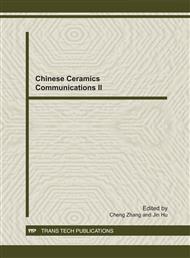p.267
p.271
p.275
p.280
p.285
p.290
p.294
p.298
p.302
Structure and Piezoelectric Properties of (K,Na)NbO3 Ceramics Fabricated from Microwave Hydrothermal Synthesized Powders
Abstract:
First, (K,Na)NbO3 (abbreviated as KNN) powders were synthesized by microwave hydrothermal method using Nb2O5, NaOH and KOH as raw materials. The effects of NaOH/KOH mole ratio and reaction temperature on the structure of KNN powders were studied systematically. Near spherical KNN powders of about 800 nm in diameter can be obtained at the optimized processing parameters as follows: NaOH/KOH mole ratio was 1.40/4.60, reaction temperature was 200 °C. Second, the ceramics were successfully prepared from the microwave hydrothermal synthesized KNN powders under 1090 °C for 2 h. This ceramic sample showed the enhanced piezoelectric properties such as piezoelectric constant d33=142 pC/N and planar electromechanical coupling coefficient kp=38%, in addition to other good properties as relative dielectric constant εr=426, Curie temperature Tc=410 °C, remnant polarization Pr=17.45μC/cm2 and coercive field Ec=1.41 kV/mm, indicating that microwave hydrothermal method can improve the properties of KNN ceramics high efficiently.
Info:
Periodical:
Pages:
285-289
Citation:
Online since:
November 2011
Authors:
Keywords:
Price:
Сopyright:
© 2012 Trans Tech Publications Ltd. All Rights Reserved
Share:
Citation:


